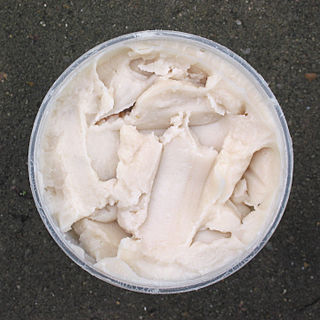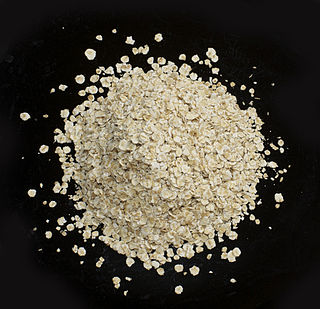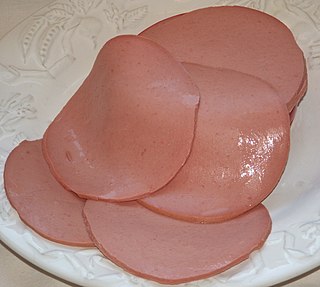
The oat, sometimes called the common oat, is a species of cereal grain grown for its seed, which is known by the same name. While oats are suitable for human consumption as oatmeal and rolled oats, one of the most common uses is as livestock feed. Oats are a nutrient-rich food associated with lower blood cholesterol when consumed regularly.

Animal fats and oils are lipid materials derived from animals. Physically, oils are liquid at room temperature, and fats are solid. Chemically, both fats and oils are composed of triglycerides. Although many animal parts and secretions may yield oil, in commercial practice, oil is extracted primarily from rendered tissue fats obtained from livestock animals like pigs, chickens and cows. Dairy products also yield popular animal fat and oil products such as cheese, butter, and milk.

Oatmeal is a type of coarse flour made of hulled oat grains – groats – that have either been milled (ground), steel-cut, or rolled. Ground oats are also called "white oats". Steel-cut oats are known as "coarse oatmeal" or "Irish oatmeal" or "pinhead oats". Rolled oats can be either thick or thin, and may be "old-fashioned", or "quick", or "instant". The term "oatmeal" is also used in the U.S. and parts of Canada as another word for an oat-based porridge popular in such countries made from either ground, steel-cut, or rolled oats.

Finnish cuisine is notable for generally combining traditional country fare and haute cuisine with contemporary continental style cooking. Fish and meat play a prominent role in traditional Finnish dishes in some parts of the country, while the dishes elsewhere have traditionally included various vegetables and mushrooms. Evacuees from Karelia contributed to foods in other parts of Finland.

Blood sausages, often called blood pudding in the United Kingdom are sausages filled with blood that are cooked or dried and mixed with a filler until they are thick enough to solidify when cooled. Variants are found worldwide. Pig, cow, sheep, duck, and goat blood can be used, varying by country.

Textured or texturized vegetable protein (TVP), also known as textured soy protein (TSP), soy meat, or soya chunks is a defatted soy flour product, a by-product of extracting soybean oil. It is often used as a meat analogue or meat extender. It is quick to cook, with a protein content comparable to certain meats.

A meat analogue, also called a meat alternative, meat substitute, mock meat, faux meat, imitation meat, vegetarian meat, or vegan meat, approximates certain aesthetic qualities and/or chemical characteristics of specific types of meat.
Ground beef, minced beef or beef mince is beef that has been finely chopped with a knife or a meat grinder or mincing machine. It is used in many recipes including hamburgers and spaghetti Bolognese.

Cumberland sausage is a form of sausage that originated in the ancient county of Cumberland, England, now part of Cumbria. They are traditionally very long, up to 21 inches, and sold rolled in a flat, circular coil, but within western Cumbria, they are more often served in long, curved lengths.

Goetta is a meat-and-grain sausage or mush of German inspiration that is popular in the greater Cincinnati area. It is primarily composed of ground meat, pin-head oats and spices. It was originally a dish meant to stretch out servings of meat over several meals to conserve money, and is a similar dish to scrapple and livermush, both also developed by German immigrants.
An adulterant is a substance found within other substances such as food, cosmetics, pharmaceuticals, fuel or other chemicals that compromises the safety or effectiveness of said substance.

Charcuterie is the branch of cooking devoted to prepared meat products, such as bacon, ham, sausage, terrines, galantines, ballotines, pâtés, and confit, primarily from pork.

Bologna sausage, also called baloney and known in Australia, Britain, Ireland, Zimbabwe and South Africa as polony, is a sausage derived from mortadella, a similar-looking, finely ground pork sausage containing cubes of pork fat, originally from the Italian city of Bologna. Aside from pork, bologna can be made out of chicken, turkey, beef, venison, a combination, or soy protein. Typical seasoning for bologna includes black pepper, nutmeg, allspice, celery seed, and coriander, and like mortadella, myrtle berries give it its distinctive flavor. U.S. government regulations require American bologna to be finely ground and without visible pieces of fat.

Liechtensteiner cuisine is the cuisine of Liechtenstein. The cuisine is diverse and has been influenced by the cuisine of nearby countries, particularly Switzerland and Austria, and is also influenced by Central European cuisine. Cheeses and soups are integral parts of Liechtensteiner cuisine. Milk products are also commonplace in the country's cuisine, due to an expansive dairy industry. Common vegetables include greens, potatoes and cabbage. Widely consumed meats include beef, chicken and pork. The consumption of three meals a day is commonplace, and meals are often formal.

A vacuum filler is a machine used for filling pasty products. The pasty products are moved with the aid of a vane cell feed system under a vacuum.

Beyond Meat is a privately held, Los Angeles-based producer of plant-based meat substitutes founded in 2009 by Ethan Brown. Beyond Meat's products became available across the United States in 2013 at Whole Foods supermarkets. In May 2016, it released the first plant-based burger to be sold in the meat section of grocery stores. Product availability has expanded internationally to restaurants and supermarkets in the US, Canada, Europe, and Israel. The company, as of 2019, has products designed to replace chicken meat, beef, and pork sausage.

Naem is a pork sausage in Thai cuisine. It is a fermented food that has a sour flavor. It typically has a short shelf life, and is often eaten in raw form after the fermentation process has occurred. It is a popular Thai food, and different regions of Thailand have various preferred flavors, including variations of sour and spicy. Naem is used as an ingredient in various dishes and is also served as a side dish. Naem has its origin in Vietnam. Naem was originally a Vietnamese type of sour sausage called Nem Chua that Vietnamese eat during drinking beers. Vietnamese immigrants came to Thailand and brought over this sausage and are now making them in Thailand.



















